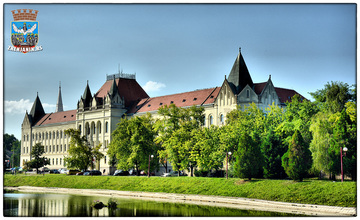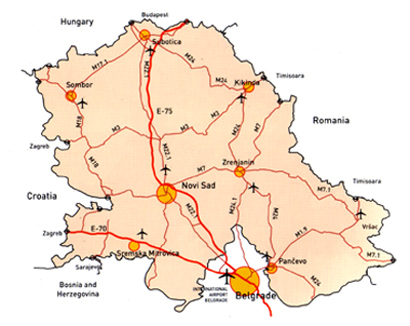Geographical position

Autonomus Province of Vojvodina
General Information
The Province of Vojvodina is a northern part of the Republic of Serbia. It covers an area of 21,506 km2 and is divided into three regions, by the rivers Danube and Tisa: Srem, Banat and Bačka. According to the census 2002, the Province has population of 2,013,992.
The ethnic heterogeneity is pronounced in Vojvodina, where people of about thirty different nations live and work together having and experiencing absolutely the same political, economic and cultural rights: the Serbs (71%), the Hungarians (7%), the Romanians, the Slovaks, the Ruthenians etc. The territory of Vojvodina is exceptionally flat (the Pannonian plain) and fertile.
In addition to its very favorable climatic and soil conditions for agriculture, it is country’s main oil and natural gas basin.The only highland areas are Fruška Gora Hill (the highest point 539m) and Vršac Hill (641m).
The capital of Vojvodina is Novi Sad (about 300,000 inhabitants). Other large cities are Subotica, Zrenjanin, Pančevo, Sombor, Kikinda, Vršac, Sremska Mitrovica. This area has been settled since Paleolithic period. The Slavs came in the 6th century, the Hungarians conquered Srem in 896 AC. The Serbs settled this area in 16th century. In the second half of the 18th century, after the Maria Theresia’s wars, and after the Turks had left this area, Vojvodina was settled by Germans, Slovaks, Romanians and Ruthenians . In 1849 this area became the Serbs Dukedom and Tamiš Banat, which was rescinded in 1860.
After World War I, Vojvodina became a part of the Kingdom of Serbs, Croats and Slovenes and since 1945 it is the aoutnomous province within the Republic of Serbia.

Economy
Vojvodina is all plain area with only two low mountains (Vrsačke planine, Fruška gora), arable land, rivers oil and gas fields. It is the most developed economic area in Serbia. The most develeoped economic branches are agriculture, food industry, metal and chemical industry, civil engineering, textile industry etc. In the national income of Vojvodina, agriculture presents about 30 %, and industry about 36 %. The arable land of Vojvodina covers 1,78 million hectars of high quality land ( 84% of total are of the Province). The significant potential of further development is canal network of hydro system Danbe-Tisa-Danube 930 km long, including 591 km navigable routes.This watering system provides irrigation for a half million hectars resulting in more than one harvest a year.
Metal industry produces machines for metal processing, agriculture machines, energy and telecommunication cables, electrical rotating machines, products of ship building. Oil rafineries have been built in Novi Sad and Pancevo, and the production of fertilizers and agrochemistry are also devleoped as well as the production of methanol, acetic acid, ethylene and prophylene, rubber processing, pharmaceuticals. The industry of building material and non metal industry make high quality products such asbricks, roof tiles, wall and floor tiles, glass, thermoinsulation material etc. Textile industry is famous for high quality carpet production. The only pulp and paper factory is located in Vojvodina (Matroz in Sremska Mitrovica).
 Skupstinagrada Zrenjanina
Skupstinagrada Zrenjanina